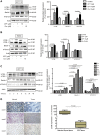Cryptotanshinone Inhibits the Growth of HCT116 Colorectal Cancer Cells Through Endoplasmic Reticulum Stress-Mediated Autophagy
- PMID: 34220498
- PMCID: PMC8248532
- DOI: 10.3389/fphar.2021.653232
Cryptotanshinone Inhibits the Growth of HCT116 Colorectal Cancer Cells Through Endoplasmic Reticulum Stress-Mediated Autophagy
Abstract
Among cancers, colorectal cancer (CRC) has one of the highest annual incidence and death rates. Considering severe adverse reactions associated with classical chemotherapy medications, traditional Chinese medicines have become potential drug candidates. In the current study, the effects of cryptotanshinone (CPT), a major component of Salvia miltiorrhiza Bunge (Danshen) on CRC and underlying mechanism were explored. First of all, data from in vitro experiments and in vivo zebrafish models indicated that CPT selectively inhibited the growth and proliferation of HCT116 and SW620 cells while had little effect on SW480 cells. Secondly, both ER stress and autophagy were associated with CRC viability regulation. Interestingly, ER stress inhibitor and autophagy inhibitor merely alleviated cytotoxic effects on HCT116 cells in response to CPT stimulation, while have little effect on SW620 cells. The significance of apoptosis, autophagy and ER stress were verified by clinical data from CRC patients. In summary, the current study has revealed the anti-cancer effects of CPT in CRC by activating autophagy signaling mediated by ER stress. CPT is a promising drug candidate for CRC treatment.
Keywords: apoptosis; autophagy; colorectal cancer; cryptotanshinone; endoplasmic reticulum stress.
Copyright © 2021 Fu, Zhao, Li, Zhou and Chen.
Conflict of interest statement
The authors declare that the research was conducted in the absence of any commercial or financial relationships that could be construed as a potential conflict of interest.
Figures








Similar articles
-
Repurposing Brigatinib for the Treatment of Colorectal Cancer Based on Inhibition of ER-phagy.Theranostics. 2019 Jul 9;9(17):4878-4892. doi: 10.7150/thno.36254. eCollection 2019. Theranostics. 2019. PMID: 31410188 Free PMC article.
-
Endoplasmic reticulum stress triggered by Soyasapogenol B promotes apoptosis and autophagy in colorectal cancer.Life Sci. 2019 Feb 1;218:16-24. doi: 10.1016/j.lfs.2018.12.023. Epub 2018 Dec 14. Life Sci. 2019. Retraction in: Life Sci. 2020 Aug 1;254:117825. doi: 10.1016/j.lfs.2020.117825. PMID: 30553871 Retracted.
-
Targeting autophagy enhances apatinib-induced apoptosis via endoplasmic reticulum stress for human colorectal cancer.Cancer Lett. 2018 Sep 1;431:105-114. doi: 10.1016/j.canlet.2018.05.046. Epub 2018 May 30. Cancer Lett. 2018. PMID: 29859300
-
New frontiers in the treatment of colorectal cancer: Autophagy and the unfolded protein response as promising targets.Autophagy. 2017 May 4;13(5):781-819. doi: 10.1080/15548627.2017.1290751. Epub 2017 Feb 23. Autophagy. 2017. PMID: 28358273 Free PMC article. Review.
-
Anticancer potential of cryptotanshinone on breast cancer treatment; A narrative review.Front Pharmacol. 2022 Sep 16;13:979634. doi: 10.3389/fphar.2022.979634. eCollection 2022. Front Pharmacol. 2022. PMID: 36188552 Free PMC article. Review.
Cited by
-
Apolipoprotein B100 acts as a tumor suppressor in ovarian cancer via lipid/ER stress axis-induced blockade of autophagy.Acta Pharmacol Sin. 2025 May;46(5):1445-1461. doi: 10.1038/s41401-024-01470-x. Epub 2025 Jan 29. Acta Pharmacol Sin. 2025. PMID: 39880927
-
PRKCSH enhances colorectal cancer radioresistance via IRE1α/XBP1s-mediated DNA repair.Cell Death Dis. 2025 Apr 6;16(1):258. doi: 10.1038/s41419-025-07582-4. Cell Death Dis. 2025. PMID: 40189587 Free PMC article.
-
Advances on Natural Abietane, Labdane and Clerodane Diterpenes as Anti-Cancer Agents: Sources and Mechanisms of Action.Molecules. 2022 Jul 26;27(15):4791. doi: 10.3390/molecules27154791. Molecules. 2022. PMID: 35897965 Free PMC article. Review.
-
Miltirone enhances the chemosensitivity of gastric cancer cells to cisplatin by suppressing the PI3K/AKT signaling pathway.Front Pharmacol. 2025 Apr 7;16:1553791. doi: 10.3389/fphar.2025.1553791. eCollection 2025. Front Pharmacol. 2025. PMID: 40260390 Free PMC article.
-
Pharmacological Mechanisms of Cryptotanshinone: Recent Advances in Cardiovascular, Cancer, and Neurological Disease Applications.Drug Des Devel Ther. 2024 Dec 15;18:6031-6060. doi: 10.2147/DDDT.S494555. eCollection 2024. Drug Des Devel Ther. 2024. PMID: 39703195 Free PMC article. Review.
References
LinkOut - more resources
Full Text Sources

